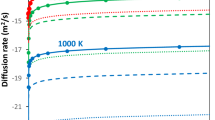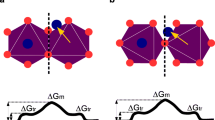Abstract
Water can be incorporated into the lattice of mantle minerals in the form of protons charge-balanced by the creation of cation vacancies. These protonated vacancies, when they interact with dislocations, influence strain rates by affecting dislocation climb, pinning the dislocation, and, potentially, by altering the Peierls barrier to glide. We use atomic scale simulations to investigate segregation of Mg vacancies to atomic sites within the core regions of dislocations in MgO. Energies are computed for bare and \(V_{{{\text{Mg}}}}^{\prime \prime }\) protonated Mg vacancies occupying atomic sites close to ½ 〈110〉 screw dislocations, and ½ 〈110〉 {100} and ½ 〈110〉 {110} edge dislocations. These are compared with energies for equivalent defects in the bulk lattice to determine segregation energies for each defect. Mg vacancies preferentially bind to ½ 〈110〉 {100} edge dislocations, with calculated minimum segregation energies of − 3.54 eV for and − 4.56 eV for \({\text{2H}}_{{{\text{Mg}}}}^{{\text{x}}}\). The magnitudes of the minimum segregation energies calculated for defects binding to ½ 〈110〉 {110} edge or ½ 〈110〉 screw dislocations are considerably lower. Interactions with the dislocation strain field lift the threefold energy degeneracy of the \({\text{2H}}_{{{\text{Mg}}}}^{{\text{x}}}\) defect in MgO. These calculations show that Mg vacancies interact strongly with dislocations in MgO, and may be present in sufficiently high concentrations to affect dislocation mobility in both the glide- and climb-controlled creep regimes.







Similar content being viewed by others
References
Amodeo J, Carrez P, Devincre B, Cordier P (2011) Multiscale modelling of MgO plasticity. Acta Mater 59:2291–2301. https://doi.org/10.1016/j.actamat.2010.12.020
Amodeo J, Carrez P, Cordier P (2012) Modelling the effect of pressure on the critical shear stress of MgO single crystals. Phil Mag 92:1523–1541. https://doi.org/10.1080/14786435.2011.652689
Ashbee KHG, Yust CS (1982) A mechanism for the ease of slip in UO2 + x. J Nucl Mater 110:246–250. https://doi.org/10.1016/0022-3115(82)90152-0
Bilby BA (1950) On the interactions of dislocations and solute atoms. Proc Phys Soc A 63:191. https://doi.org/10.1088/0370-1298/63/3/302
Bolfan-Casanova N, Keppler H, Rubie DC (2000) Water partitioning between nominally anhydrous minerals in the MgO–SiO2–H2O system up to 24 GPa: implications for the distribution of water in the Earth’s mantle. Earth Planet Sci Letters 182:209–221. https://doi.org/10.1016/S0012-821X(00)00244-2
Bolfan-Casanova N, Mackwell S, Keppler H et al (2002) Pressure dependence of H solubility in magnesiowüstite up to 25 GPa: implications for the storage of water in the Earth’s lower mantle. Geophys Res Lett 29:89. https://doi.org/10.1029/2001GL014457
Bulatov VV, Kaxiras E (1997) Semidiscrete variational peierls framework for dislocation core properties. Phys Rev Lett 78:4221–4224. https://doi.org/10.1103/PhysRevLett.78.4221
Cai W, Bulatov VV, Chang J et al (2001) Anisotropic elastic interactions of a periodic dislocation array. Phys Rev Lett 86:5727–5730. https://doi.org/10.1103/PhysRevLett.86.5727
Cai W, Bulatov VV, Chang J et al (2003) Periodic image effects in dislocation modelling. Phil Mag 83:539–567. https://doi.org/10.1080/0141861021000051109
Carrez P, Godet J, Cordier P (2015) Atomistic simulations of ½(1 1 0) screw dislocation core in magnesium oxide. Comput Mater Sci 103:250–255. https://doi.org/10.1016/j.commatsci.2014.10.019
Cline IICJ, Faul UH, David EC et al (2018) Redox-influenced seismic properties of upper-mantle olivine. Nature 555:355–358. https://doi.org/10.1038/nature25764
Cordier P, Amodeo J, Carrez P (2012) Modelling the rheology of MgO under Earth/’s mantle pressure, temperature and strain rates. Nature 481:177–180. https://doi.org/10.1038/nature10687
Cottrell AH, Bilby BA (1949) Dislocation theory of yielding and strain ageing of iron. Proc Phys Soc A 62:49. https://doi.org/10.1088/0370-1298/62/1/308
de Leeuw NH (2001) Density functional theory calculations of hydrogen-containing defects in forsterite, periclase, and α-Quartz. J Phys Chem B 105:9747–9754. https://doi.org/10.1021/jp0109978
Gale JD (1997) GULP: A Computer program for the symmetry-adapted simulation of solids. J Chem Soc Faraday Trans 93:629–637. https://doi.org/10.1039/A606455H
Gale JD, Rohl AL (2003) The general utility lattice program (GULP). Mol Simul 29:291–341. https://doi.org/10.1080/0892702031000104887
Gatzemeier A, Wright K (2006) Computer modelling of hydrogen defects in the clinopyroxenes diopside and jadeite. Phys Chem Miner 33:115. https://doi.org/10.1007/s00269-006-0059-0
Girard J, Amulele G, Farla R et al (2016) Shear deformation of bridgmanite and magnesiowüstite aggregates at lower mantle conditions. Science 351:144–147. https://doi.org/10.1126/science.aad3113
Hartley CS, Mishin Y (2005a) Characterization and visualization of the lattice misfit associated with dislocation cores. Acta Mater 53:1313–1321. https://doi.org/10.1016/j.actamat.2004.11.027
Hartley CS, Mishin Y (2005b) Representation of dislocation cores using Nye tensor distributions. Mater Sci Eng 400–401:18–21. https://doi.org/10.1016/j.msea.2005.03.076
Henkelman G, Uberuaga BP, Harris DJ et al (2005) MgO addimer diffusion on MgO(100): a comparison of ab initio and empirical models. Phys Rev B 72:115437. https://doi.org/10.1103/PhysRevB.72.115437
Hohenberg P, Kohn W (1964) Inhomogeneous electron gas. Phys Rev 136:B864–B871. https://doi.org/10.1103/PhysRev.136.B864
Ismail-Beigi S, Arias TA (2000) Ab initio study of screw dislocations in Mo and Ta: a new picture of plasticity in bcc transition metals. Phys Rev Lett 84:1499–1502. https://doi.org/10.1103/PhysRevLett.84.1499
Joachim B, Wohlers A, Norberg N et al (2012) Diffusion and solubility of hydrogen and water in periclase. Phys Chem Miner 40:19–27. https://doi.org/10.1007/s00269-012-0542-8
Karki BB, Wentzcovitch RM, Gironcoli S de, Baroni S (1999) First-principles determination of elastic anisotropy and wave velocities of MgO at lower mantle conditions. Science 286:1705–1707. https://doi.org/10.1126/science.286.5445.1705
Karki BB, Ghosh DB, Verma AK (2015) First-principles prediction of pressure-enhanced defect segregation and migration at MgO grain boundaries. Am Miner 100:1053–1058. https://doi.org/10.2138/am-2015-5143
Katayama I, Karato S (2008) Low-temperature, high-stress deformation of olivine under water-saturated conditions. Phys Earth Planet Inter 168:125–133. https://doi.org/10.1016/j.pepi.2008.05.019
Kohn W, Sham LJ (1965) Self-consistent equations including exchange and correlation effects. Phys Rev 140:A1133–A1138. https://doi.org/10.1103/PhysRev.140.A1133
Kröger FA, Vink HJ (1956) Relations between the concentrations of imperfections in crystalline solids. Solid State Phys 3:307–435. https://doi.org/10.1016/S0081-1947(08)60135-6
Lauzier J, Hillairet J, Vieux-Champagne A, Benoit W (1989) The vacancies, lubrication agents of dislocation motion in aluminium. J Phys 1:9273. https://doi.org/10.1088/0953-8984/1/47/001
Leslie M, Gillan NJ (1985) The energy and elastic dipole tensor of defects in ionic crystals calculated by the supercell method. J Phys C 18:973. https://doi.org/10.1088/0022-3719/18/5/005
Lewis GV, Catlow CRA (1985) Potential models for ionic oxides. J Phys C 18:1149. https://doi.org/10.1088/0022-3719/18/6/010
Long MD, Xiao X, Jiang Z et al (2006) Lattice preferred orientation in deformed polycrystalline (Mg,Fe)O and implications for seismic anisotropy in D″. Phys Earth Planet Inter 156:75–88. https://doi.org/10.1016/j.pepi.2006.02.006
Lu G, Kaxiras E (2002) Can vacancies lubricate dislocation motion in aluminum? Phys Rev Lett 89:105501. https://doi.org/10.1103/PhysRevLett.89.105501
Madi K, Forest S, Cordier P, Boussuge M (2005) Numerical study of creep in two-phase aggregates with a large rheology contrast: Implications for the lower mantle. Earth Planet Sci Lett 237:223–238. https://doi.org/10.1016/j.epsl.2005.06.027
Mahendran S, Carrez P, Groh S, Cordier P (2017) Dislocation modelling in Mg 2 SiO 4 forsterite: an atomic-scale study based on the THB1 potential. Modell Simul Mater Sci Eng 25:054002. https://doi.org/10.1088/1361-651X/aa6efa
Marquardt H, Speziale S, Reichmann HJ et al (2009) Elastic Shear anisotropy of ferropericlase in earth’s lower mantle. Science 324:224–226. https://doi.org/10.1126/science.1169365
Miller MK (2006) Atom probe tomography characterization of solute segregation to dislocations and interfaces. J Mater Sci 41:7808–7813. https://doi.org/10.1007/s10853-006-0518-5
Muir JMR, Brodholt JP (2018) Water distribution in the lower mantle: implications for hydrolytic weakening. Earth Planet Sci Lett 484:363–369. https://doi.org/10.1016/j.epsl.2017.11.051
Piazolo S, Fontaine AL, Trimby P et al (2016) Deformation-induced trace element redistribution in zircon revealed using atom probe tomography. Nat Commun 7:10490. https://doi.org/10.1038/ncomms10490
Puls MP (1980) Vacancy-dislocation interaction energies in MgO. Philos Mag A 41:353–368. https://doi.org/10.1080/01418618008239317
Puls MP (1983) Vacancy-dislocation interaction energies in MgO A re-analysis. Philos Mag A 47:497–513. https://doi.org/10.1080/01418618308245242
Puls MP, Norgett MJ (1976) Atomistic calculation of the core structure and Peierls energy of an (a/2) [110] edge dislocation in MgO. J Appl Phys 47:466–477. https://doi.org/10.1063/1.322670
Reddy SM, van Riessen A, Saxey DW et al (2016) Mechanisms of deformation-induced trace element migration in zircon resolved by atom probe and correlative microscopy. Geochim Cosmochim Acta 195:158–170. https://doi.org/10.1016/j.gca.2016.09.019
Schroder K-P, Sauer J, Leslie M et al (1992) Bridging hydrodyl groups in zeolitic catalysts: a computer simulation of their structure, vibrational properties and acidity in protonated faujasites (HîY zeolites). Chem Phys Lett 188:320–325. https://doi.org/10.1016/0009-2614(92)90030-Q
Shanno DF (1970) Conditioning of quasi-Newton methods for function minimization. Math Comp 24:647–656. https://doi.org/10.1090/S0025-5718-1970-0274029-X
Skelton R, Walker AM (2018) Lubrication of dislocation glide in MgO by hydrous defects. Phys Chem Miner 45:713–726. https://doi.org/10.1007/s00269-018-0957-y
Stroh AN (1958) Dislocations and cracks in anisotropic elasticity. Phil Mag 3:625–646. https://doi.org/10.1080/14786435808565804
Ventelon L, Lüthi B, Clouet E et al (2015) Dislocation core reconstruction induced by carbon segregation in bcc iron. Phys Rev B 91:220102. https://doi.org/10.1103/PhysRevB.91.220102
Verma AK, Karki BB (2010) First-principles simulations of MgO tilt grain boundary: structure and vacancy formation at high pressure. Am Miner 95:1035–1041. https://doi.org/10.2138/am.2010.3386
Walker AM, Gale JD, Slater B, Wright K (2005a) Atomic scale modelling of the cores of dislocations in complex materials part 1: methodology. Phys Chem Chem Phys 7:3227–3234. https://doi.org/10.1039/B505612H
Walker AM, Gale JD, Slater B, Wright K (2005b) Atomic scale modelling of the cores of dislocations in complex materials part 2: applications. Phys Chem Chem Phys 7:3235–3242. https://doi.org/10.1039/B505716G
Watson GW, Kelsey ET, Parker SC (1999) Atomistic simulation of screw dislocations in rock salt structured materials. Philos Mag A 79:527–536. https://doi.org/10.1080/01418619908210314
Wolf D, Keblinski P, Phillpot SR, Eggebrecht J (1999) Exact method for the simulation of Coulombic systems by spherically truncated, pairwise r—1 summation. J Chem Phys 110:8254–8282. https://doi.org/10.1063/1.478738
Zhang F, Walker AM, Wright K, Gale JD (2010) Defects and dislocations in MgO: atomic scale models of impurity segregation and fast pipe diffusion. J Mater Chem 20:10445–10451. https://doi.org/10.1039/C0JM01550D
Acknowledgements
AMW is grateful for support from the UK Natural Environment Research Council (NE/K008803/1 and NE/M000044/1). RS is supported by an Australian Government Research Training Program (RTP) Scholarship. Calculations were performed on the Terrawulf cluster, a computational facility supported through the AuScope initiative. AuScope Ltd is funded under the National Collaborative Research Infrastructure Strategy (NCRIS), an Australian Commonwealth Government Programme. Ian Jackson is thanked for helpful comments made during the preparation of the manuscript. The authors would like to thank Taku Tsuchiya for his editorial handling, and Sebastian Ritterbex and an anonymous reviewer for constructive comments which improved the quality of the manuscript.
Author information
Authors and Affiliations
Corresponding author
Additional information
Publisher’s Note
Springer Nature remains neutral with regard to jurisdictional claims in published maps and institutional affiliations.
Rights and permissions
About this article
Cite this article
Skelton, R., Walker, A.M. Interactions between bare and protonated Mg vacancies and dislocation cores in MgO. Phys Chem Minerals 46, 471–485 (2019). https://doi.org/10.1007/s00269-018-01017-7
Received:
Accepted:
Published:
Issue Date:
DOI: https://doi.org/10.1007/s00269-018-01017-7




